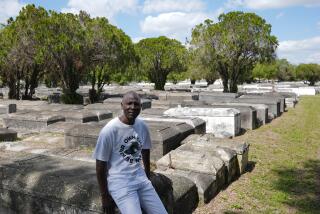Fleshing Out Life Shrouded in Mystery
- Share via
CHARLOTTESVILLE, Va. — Beneath the stately oaks that shelter Miss Kitty’s grave, the actor blinks back tears.
Then he composes himself and turns to his audience. Wide-eyed, his voice exaggerated, he shuffles toward an imaginary young woman sweeping an imaginary stoop.
“I figured out why your mama never let us in the house,” he booms. “She got stowaways in there.”
The scene is played out on the grounds of the University of Virginia, beside the grave of Catherine Foster, the mysterious 19th century black woman who once lived on this site. Her remains were discovered when a backhoe struck a coffin in 1993.
The find stunned university officials, who had planned to use the land for a parking lot. Instead, Foster’s grave has become an archeological shrine, her life the subject of endless historical debate and theatrical reenactments.
Because so little is known about how Foster lived and died, some faculty members have constructed a past for her. Using shreds of historical facts, gleaned from the site, they have created a life.
That is why Ishmail Conway, assistant dean of African American affairs, is standing by Foster’s grave, pretending that it is 140 years ago and that he is talking to her daughter. Conway plays a young man who has returned, after 12 years, to the neighborhood where they both grew up.
Passionately, cleverly, he fills the conversation with hints of Foster’s past. He asks about her work, and we learn she was a seamstress. He mentions the house, and we learn that Miss Kitty was an educated woman who bought her land and her freedom. He raises the subject of stowaways to suggest that she was active in the underground railroad.
Conway doesn’t know if he is being completely true to history. But, he says, it is one way to engage people in the study of that time--and to make sure a remarkable woman is not forgotten.
“Historians get to the point where they have stuff, but that stuff has no life,” says Conway, who also teaches drama. “History, especially black history, has to be intuitive as well as factual.”
What is known about Foster is that in 1833 she paid $450 for the two-acre plot on Venable Lane, that her family lived there until 1906, and that some of her daughters were seamstresses.
Did she, as researchers believe, live in a neighborhood of skilled free black workers who served the university? Did she wash and sew clothes for students and faculty? As a mixed-race woman--she is described as “mulatto” in the 1850 census--did she sometimes pass as white?
And the biggest question for some: Two years after Nat Turner’s failed slave rebellion, how did a black woman manage to buy a parcel of land once owned by President James Monroe?
The documents don’t hold answers, only clues. The same is true of other finds at the site: 12 coffins, the foundation of a house, a button, broken dishes, fragments of dolls.
The university hasn’t decided what to do with these bits of history, or with the site itself, which was covered with earth after the initial excavation. Today it sits, unmarked, a small grassy knoll tucked off a busy campus street.
It’s not sure what to do about Catherine Foster, either.
Her presence is unnerving to some in this stately antebellum school that only opened its doors to blacks in 1970. Before Foster was discovered, not much attention had been given to the role free black workers in the university’s past.
Now they talk about it in history classes. They study the old black neighborhoods. And, occasionally, they act out scenes from Foster’s life.
The original reenactment a few years ago was an emotional affair that drew crowds of historians and archeologists. At the end, they stood around her grave and held hands and prayed.
They prayed that they were being true to Catherine Foster and her kin, that they were somehow contributing to history, that they were doing the right thing.
More to Read
Sign up for Essential California
The most important California stories and recommendations in your inbox every morning.
You may occasionally receive promotional content from the Los Angeles Times.













